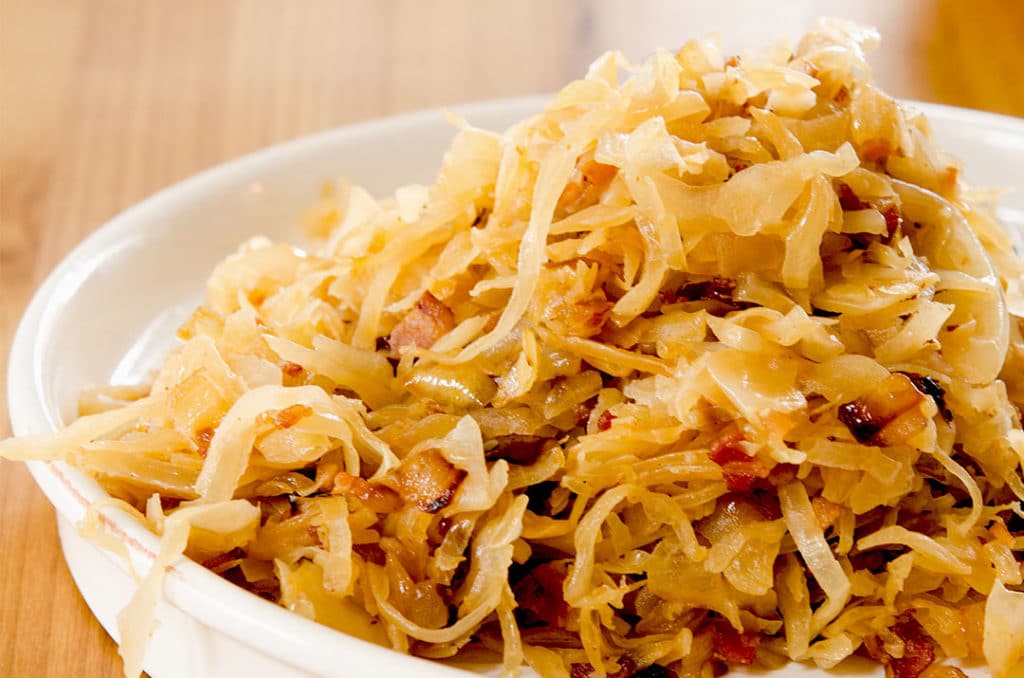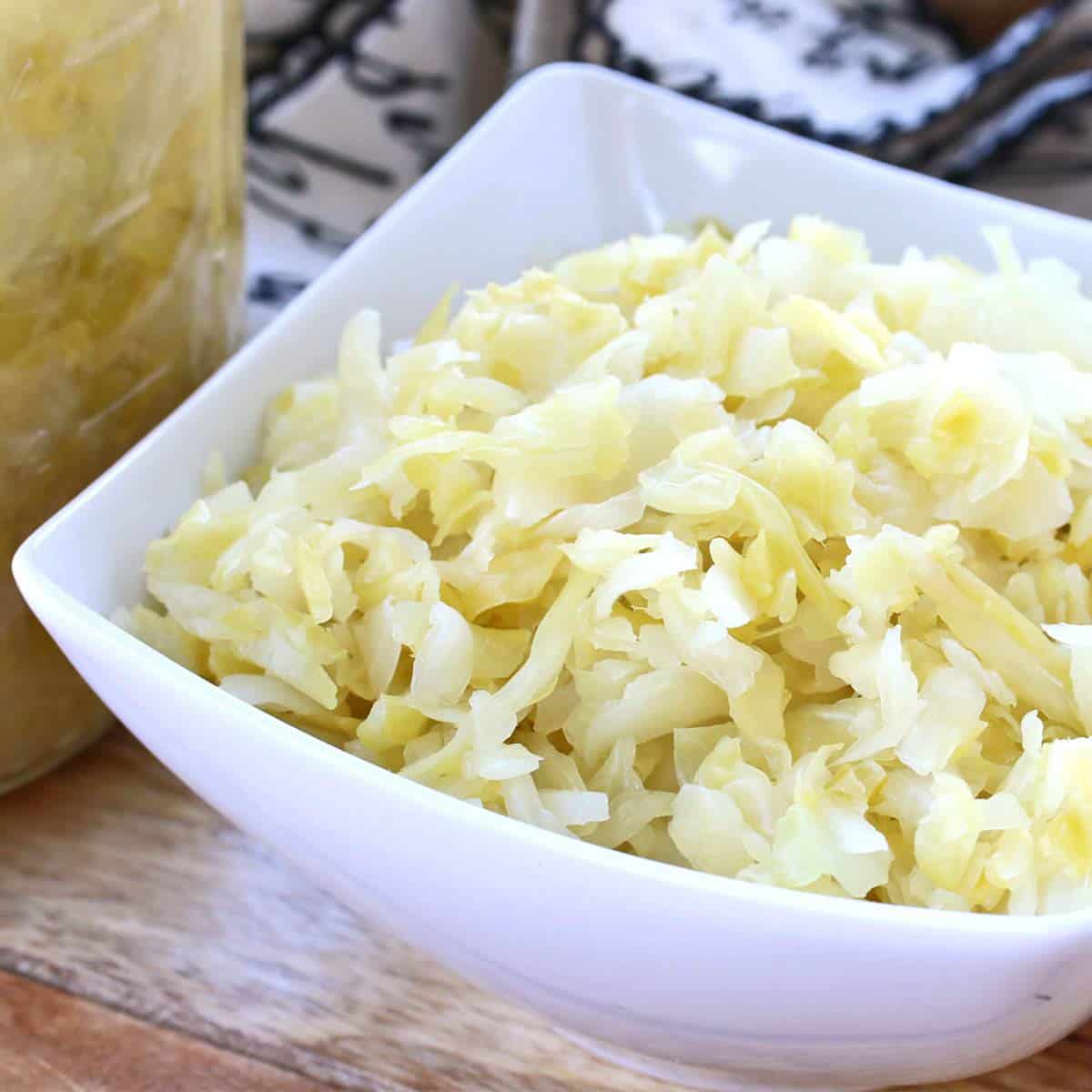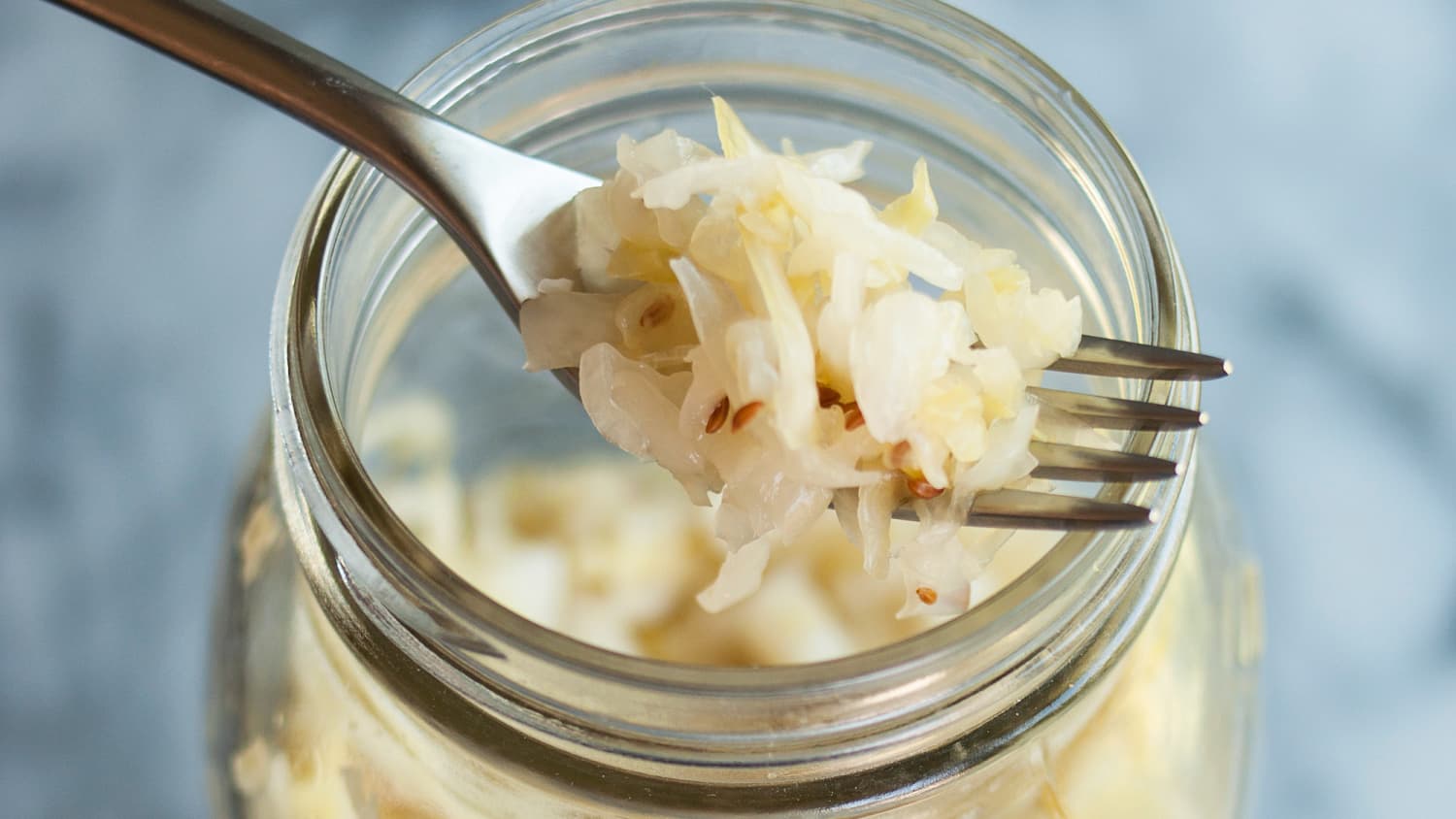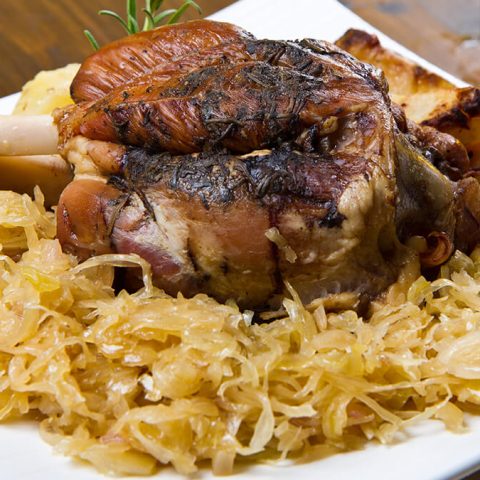A comprehensive, step-by-step pictured tutorial on How to Make Sauerkraut that is incredibly healthy and delicious! Making your own fermented homemade sauerkraut is super easy, requires minimal prep work, and the rest is just a waiting game!
Sauerkraut is in my blood. Being from Germany and raised by a health-conscious mom, I ate this stuff on a regular basis. In Germany sauerkraut is eaten fresh or cooked in a wide variety of dishes; everything from casseroles and soups to salads or alongside meats and sausages. Raw fermented sauerkraut was always readily available in our local health food stores. My mom and I regularly went to our local Reformhaus and in the refrigerated section was a large vat of fresh sauerkraut where we could scoop out as little or as much as we wanted into the bags provided. We’d often nibble on some of it as we made our way through the outdoor shopping district and then take the rest home with us. This ancient skill has been making a comeback in recent years both overseas and in the U.S., with a growing number of people learning how to ferment their own foods.
I’ve been fermenting vegetables, grains, legumes, and dairy products for over a decade and it is a deeply satisfying venture. If you’ve been curious about how to make sauerkraut it’s time to make that leap.
For anyone interested in trying their hand at fermentation, sauerkraut is the perfect place to start!

How to Make Sauerkraut

Making your own sauerkraut is super easy, requires minimal prep work, and the rest is just a waiting game. Enjoy all the health benefits of the vibrant probiotics and the superior taste of homemade sauerkraut!
Prep: 20min
Total: 20180min
Ingredients:
- 1 1/2-2 teaspoons salt for every pound of cabbage (9-12 grams salt per 450 grams of cabbage)
- very fresh green cabbage
Instruction:
- Prepare the Cabbage:Remove any bruised or damaged exterior leaves from the cabbage, then cut the cabbage in half and remove the core. Slice the cabbage very thinly, approximately 1/8 inch thick. For the best texture we recommend slicing it very thinly by hand, not with a food processor. You can slice it by hand, use a mandolin, or cabbage slicer.Place the sliced cabbage in a large bowl and toss in the salt. Let it sit for about 20 minutes until the cabbage has begun to wilt and releases some of its juices. Use a tamper/pounder to crush the cabbage until it is wilted and has released a lot of liquid. This will takes several minutes.
- Pack the Cabbage in a Crock or Jar:Transfer the cabbage and all the juices to a glass or ceramic jar or crock a bit at a time and mash it down with a tamper. Fill the jar to about 2/3 full (the cabbage will bubble as it ferments and could overflow if the jar is too full).Continue to mash the cabbage with the tamper, releasing more juice, until the cabbage is completely submerged under the brine and any air pockets have been removed (important for preventing mold growth). If you’ve mashed all you can mash and you still don’t have enough brine to cover the cabbage you’ll need to make some supplemental liquid that is consistent with the salinity of the cabbage brine: Dissolve 2 teaspoons salt in 1/2 cup water (12 grams salt in 118 grams water) and add that to the jar until the cabbage is completely submerged under the liquid.It is imperative that the cabbage remain submerged under the brine during fermentation, otherwise mold will form (See blog section “My Sauerkraut Has Mold on it: Is it Safe to Eat?”). To do this choose a heavy object whose diameter is roughly the same size to the inside of the crock you’re using. The object should be glass, ceramic, or non-reactive metal.Note: I have made sauerkraut multiples times in large mason jars (usually 1/2 gallon size but you can use smaller jars) without needing to use a weight. Because of the small diameter of the jar, after a day or two of fermenting the cabbage usually remains below the liquid level. If the cabbage rises above it I just mash it back down with the tamper. If you choose to use mason jars without using something to weigh down the cabbage, just be sure to keep a close eye on it each day throughout the fermentation process.Screw on the lids to fingertip tightness (this is important to prevent exploding jars!). If using airlock lids, follow the instructions provided.
- Ferment Your Sauerkraut:Place the jars in a dark place that is between 65-70 degrees F, the ideal temperature for fermenting. (See blog section “How Long Does it Take to Ferment Sauerkraut” for information on temperature variations.)At a the ideal temperature range of 65-70 F we recommend fermenting the cabbage for at least 2 weeks (we recommend longer) but follow your own taste.After 4 days of fermenting start tasting the cabbage daily until it reaches the desired texture and level of tanginess. Don’t be alarmed if the brine becomes fizzy, this is completely normal and a positive sign of microbial activity.Note: If you’re not using an airlock lid be sure to open the lid of your jar/crock every day to release the pressure and prevent your jar from exploding. The color of the cabbage will change from green to a pale yellowish beige.
- Store Your Sauerkraut: Once your sauerkraut has reached the level of tanginess that you want, it’s time to screw the lid on tight (remove the airlock lid if using and replace it with a regular lid).Store the sauerkraut in the fridge or a cold cellar (storage temperature should be between 38-50 degrees F). Fermentation won’t stop but it will be greatly slowed down.Stored in the fridge the sauerkraut will keep for many months. (See blog section “Does Sauerkraut Go Bad?”)Eat your sauerkraut raw to reap the benefits of the probiotics or use it in any recipe calling for sauerkraut.
How To Make Homemade Sauerkraut in a Mason Jar

When life gives you cabbage, you make sauerkraut — and homemade sauerkraut is a world apart from the stuff that comes from the grocery store.
Prep: 900sec
Total: 900sec
Serving Size: Serves 8
Nutrition Facts: Saturated Fat 0.1 g, unSaturated Fat 0.0 g, Carbohydrate 10.3 g, Sugar 5.4 g, servingSize Serves 8, Protein 2.3 g, Fat 0.3 g, calories 45 cal, Sodium 397.5 mg, Fiber 4.6 g, Cholesterol 0 mg
Ingredients:
- 1 medium head green cabbage (about 3 pounds)
- 1 1/2 tablespoons kosher salt
- 1 tablespoon caraway seeds (optional, for flavor)
Instruction:
- Clean everything. When fermenting anything, it’s best to give the good, beneficial bacteria every chance of succeeding by starting off with as clean an environment as possible. Make sure your mason jar and jelly jar are washed and rinsed of all soap residue. You’ll be using your hands to massage the salt into the cabbage, so give those a good wash, too.
- Slice the cabbage. Discard the wilted, limp outer leaves of the cabbage. Cut the cabbage into quarters and trim out the core. Slice each quarter down its length, making 8 wedges. Slice each wedge crosswise into very thin ribbons.
- Combine the cabbage and salt. Transfer the cabbage to a big bowl and sprinkle the salt over top. Begin working the salt into the cabbage by massaging and squeezing the cabbage with your hands. At first it might not seem like enough salt, but gradually the cabbage will become watery and limp — more like coleslaw than raw cabbage. This will take 5 to 10 minutes. If you’d like to flavor your sauerkraut with caraway seeds, mix them in now.
- Pack the cabbage into the jar. Grab handfuls of the cabbage and pack them into the canning jar. If you have a canning funnel, this will make the job easier. Every so often, tamp down the cabbage in the jar with your fist. Pour any liquid released by the cabbage while you were massaging it into the jar. Optional: Place one of the larger outer leaves of the cabbage over the surface of the sliced cabbage. This will help keep the cabbage submerged in its liquid.
- Weigh the cabbage down. Once all the cabbage is packed into the mason jar, slip the smaller jelly jar into the mouth of the jar and weigh it down with clean stones or marbles. This will help keep the cabbage weighed down, and eventually, submerged beneath its liquid.
- Cover the jar. Cover the mouth of the mason jar with a cloth and secure it with a rubber band or twine. This allows air to flow in and out of the jar, but prevents dust or insects from getting into the jar.
- Press the cabbage every few hours. Over the next 24 hours, press down on the cabbage every so often with the jelly jar. As the cabbage releases its liquid, it will become more limp and compact and the liquid will rise over the top of the cabbage.
- Add extra liquid, if needed. If after 24 hours, the liquid has not risen above the cabbage, dissolve 1 teaspoon of salt in 1 cup of water and add enough to submerge the cabbage.
- Ferment the cabbage for 3 to 10 days. As it’s fermenting, keep the sauerkraut away from direct sunlight and at a cool room temperature — ideally 65°F to 75°F. Check it daily and press it down if the cabbage is floating above the liquid.Because this is a small batch of sauerkraut, it will ferment more quickly than larger batches. Start tasting it after 3 days — when the sauerkraut tastes good to you, remove the weight, screw on the cap, and refrigerate. You can also allow the sauerkraut to continue fermenting for 10 days or even longer. There’s no hard-and-fast rule for when the sauerkraut is “done” — go by how it tastes.While it’s fermenting, you may see bubbles coming through the cabbage, foam on the top, or white scum. These are all signs of a healthy, happy fermentation process. The scum can be skimmed off the top either during fermentation or before refrigerating. If you see any mold, skim it off immediately and make sure your cabbage is fully submerged; don’t eat moldy parts close to the surface, but the rest of the sauerkraut is fine.
- Store sauerkraut for several months. This sauerkraut is a fermented product so it will keep for at least two months and often longer if kept refrigerated. As long as it still tastes and smells good to eat, it will be. If you like, you can transfer the sauerkraut to a smaller container for longer storage.
25 Best Sauerkraut Recipes with Meat

Try these sauerkraut recipes with meat and enjoy a delicious meal! From classic bratwursts to delicious pork roasts, there’s always something for every occasion!
Prep: 1min
Total: 1min
Serving Size: 1
Nutrition Facts: calories 512 calories, Carbohydrate 27 grams carbohydrates, Cholesterol 105 milligrams cholesterol, Fat 32 grams fat, Fiber 5 grams fiber, Protein 28 grams protein, Saturated Fat 11 grams saturated fat, servingSize 1, Sodium 1853 milligrams sodium, Sugar 7 grams sugar, Trans Fat 0 grams trans fat, unSaturated Fat 18 grams unsaturated fat
Ingredients:
- Roasted Pork Loin With Rosemary Brown Sugar Sauerkraut
- Grilled Polish Sausage & Sauerkraut
- Bierocks
- German Meatballs With Sauerkraut
- Crock Pot Pork And Sauerkraut
- Amish Sauerkraut Meatloaf
- Beer Braised Bratwurst And Caramelized Sauerkraut
- Szegedin Goulash (Székely Gulyás)
- Baked Pork Chops And Sauerkraut
- Bigos Stew (Polish Hunter’s Stew)
- Pork Hocks And Sauerkraut
- Country Style Pork Spare Ribs And Sauerkraut
- Cranberry-Sauerkraut Meatballs
- Wunderbar Knockwurst Sausage Sandwich
- Kielbasa And Sauerkraut
- German Sauerkraut Casserole With Bacon And Brown Sugar
- Sheet Pan Roasted Potatoes, Sausage and Sauerkraut
- Smoked Sausage, Sauerkraut With Potatoes And Green Beans
- Slow Cooker Corned Beef And Sauerkraut
- Beer And Bacon Sauerkraut
- Reuben Tacos
- Kielbasa, Pierogies And Sauerkraut Bake
- Hungarian Stuffed Cabbage Rolls
- Mustard-Maple Pork And Sauerkraut
- Pork Roast And Sauerkraut
Instruction:
- Choose your favorite sauerkraut recipe with meat.
- Prepare all the required ingredients.
- Whip up the tasty dish and enjoy an awesome meal!
